
Here it is, ask and you shall receive! Close up photos of the actual Olympic Arms post ban muzzle brake. These brakes are standard features on the CAR-97 and PCR-7 Eliminator models, but are options on all other factory Oly weapons.
What's the idea behind a muzzle brake? Well, to be honest it is two-fold. First off, it IS functional. It does serve a purpose on an AR-15 style firearm. The muzzle brake is designed to reduce felt recoil of the firearm, as well as reduce "muzzle jump" or "muzzle climb".
Reducing felt recoil has its obvious advantages. We really do not need to go into a great deal of detail here on this particular subject. It is fairly self explanatory as to why you'd want to reduce the recoil of any firearm. But suffice it to say that the less the recoil, the more comfortable it is to shoot, and therefore, you are more likely to shoot more often. Additionally, the better the firearms feels to the shooter, the better they will be able to shoot the gun. The more consistent and accurate a shooter can perform, the more likely we are to make a lifelong shooting sports enthusiast!
Muzzle jump is the result of (among other things) expanding gasses exiting the muzzle. Muzzle jump is best defined as the process in which the muzzle of the firearm rises in response to the firing of the weapon. The muzzle climbs upward, taking the shooter off target. The less muzzle jump, the faster the shooter has the ability to regain their sight picture, and get off a second or successive shot at the target. Sometimes speed is essential, especially in matters of self defense or law enforcement. By law of nature, expanding gasses at the muzzle are trying to equalize themselves as quickly as possible. To do this, the gas travels the path of least resistance. Or, in the case of a rifle barrel, basically straight out. This gas pressure however can be harnessed to the advantage of the shooter. This is where the muzzle brake comes in.
All Olympic Arms barrels for post ban firearms come equipped with what we call a muzzle "groove channel". This grove channel as seen here
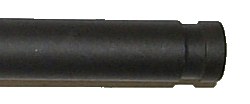
To reduce both muzzle jump and felt recoil, the expanding gasses at the muzzle (as mentioned above) can be redirected. To do this, we use a muzzle brake. As seen below.
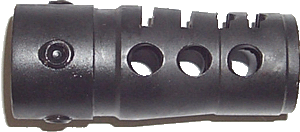
The Olympic brake is designed with an expansion chamber. This is an internal area within the brake that allows the gasses to expand, and then redirect out of the designed ports. To create an expansion chamber, the inside of the brake is machined larger than the input and muzzle ports.
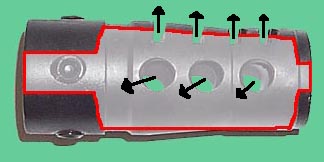
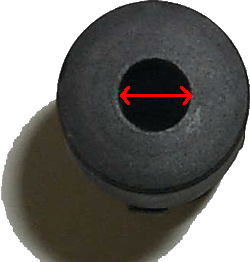 The Olympic muzzle brake looking into the muzzle opening. |
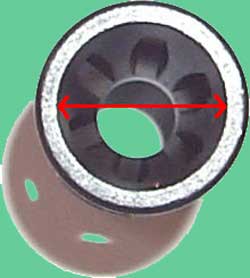 |
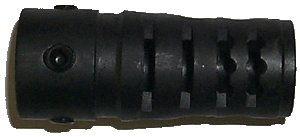
Do you need a muzzle brake? It is totally up to you. Personal preference will dictate your decision.
Part Number: MB
Cost: $35.00 each
Pistol Caliber Brakes $46.00
As an Option with firearms purchase: $25.00
| Pro's
Muzzle brakes are effective for what they are made for; reducing recoil and muzzle jump. Muzzle brakes add to the esthetics of the weapon. There is no doubt that to the average consumer a muzzle brake will make your rifle more attractive to the buyer. Added value. Having a brake does make the weapon worth more in the long run. It is an accessory, and accessories, especially factory ones will help the cash value of the gun. |
Con's Muzzle brakes will increase the report of the rifle dramatically. In other words, firing a rifle or carbine with a muzzle brake attached will be LOUD! Muzzle brakes require maintenance. Even though a factory installed brake is dome with the use of LoctiteŽ, the screw could still very well work themselves loose. If this happens, the end result will be the launching of your brake down range at a rapid rate of speed. This could be damaging to your rifle, so please make sure you check your brake before every firing session. This means make sure you have the proper sized hex-head/Allan wrench with you at the range. Accuracy loss. No matter what, a brake can, and in most cases will be detrimental to the over-all consistancy/accuracy of the rifle. Bottom line is this: if muzzle brakes made a gun more accurate all the bench rest shooters in the world would be using them. Total number of BR guys that use muzzle brakes, 0.
|
If you are unsure as to whether a brake is for you or not, my recommendation is to buy it with the gun (what else did you expect me to say, I AM after all a sales person!) But seriously, they do add value an attractiveness to your gun, and for all the more it cost, it is well worth it. Buy it, shoot it, see if you like it. If you don't, take it off and sell it, you will be able to get more than your money back for it.
Hope this helps. If you have any further questions regarding brakes or anything else for that matter, feel free to call us at 800-228-3471. We'll be glad to help you out.